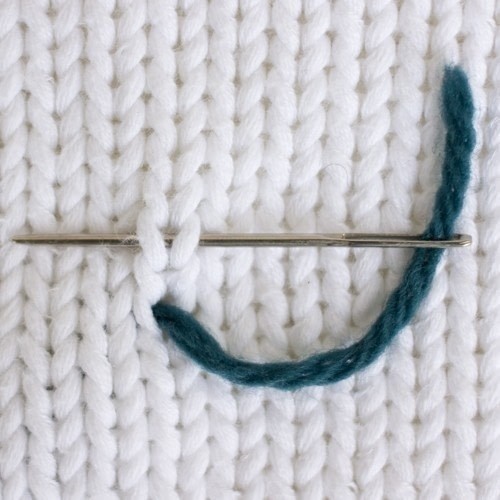
Step 2: And once you covered 6-8 stitches, you can simply cut off the ends. So instead of weaving in, you can pick up the tail and knit the first row (or just the first 6-8 stitches) with two strands held together. Step 1: If you use a standard long-tail cast-on, then your tail will always hang down right where you knit your first stitch and you start your first row or round. There are ways to avoid weaving in ends if you plan your project the right way. But there’s one important thing you should know. The methods I showed you so far all are great. That, however, often risks a little tail sticking out of your knitting after the first washing and will make the edge much thicker on top of that – especially as the edges are typically the part of your knitting that sees the most wear & tear. If you don’t like the way it looks, you can of course also go through the edges.

However, I still found it to be the least conspicuous and most secure method for garter stitch. This method pushes the ribs a bit apart, so it will be slightly visible. Step 2 (optional): Depending on the materials you are working with, you can go one more time in the other direction. Step 1: Thread your tail on your tapestry needle, push apart one of the ribs, and go right through the legs of the knit stitches for about 6-8 stitches. Instead, weave in the ends in garter stitch like this: So it’s both more visible, less secure, and not reversible on top of that. Duplicate stitch is very visible and going diagonally through the purl bumps (like you would in stockinette stitch) is not a good idea either as these purl stitches are much farther apart. If you ask me, they are all not exactly ideal. Some of them involve duplicate stitches or ask you to go diagonally on the wrong side. There are a lot of methods floating around the internet. Interestingly enough, it is not the easiest pattern to weave in tails. Now, let’s talk about the easiest knitting stitch of them all: Garter stitch. It works for any kind of ribbing and all other reversible knitting stitches with a stacked column (wale) of knit stitches. If done the right way, this method is barely visible from either side and very secure. The finished 2×2 rib swatch with the almost invisible tail in the left corner Instead, massage the tail into place and stretch out your ribbing quite a bit to let the end settle in. Step 3: Pull the tail all the way through. But this time, go right through the other legs of the same knit stitches. Step 2: Pull the tail through and weave in the rest of the tail in the opposite direction following the same rib. If your project is not reversible (like the typical cuff of a sock), then consider doing this on the wrong side. Go right through the left (or right) leg of the knit stitches. Step 1: Thread the tail on a tapestry needle and follow one rib horizontally. Instead, you have to sew in the tails like this.

And on top of that, those are typically very stretchy kinds of patterns where you don’t want to weave in ends in the same direction you end up stretching your finished project (makes it very easy for the tail to come loose). First of all, there are not enough purl bumps in a diagonal direction.

Now, if you are knitting ribbing (maybe a 2×2 rib stitch), you can’t use the first method I showed you. Some yarns are feltable, others aren’t.Īnd depending on all these characteristics, and the individual properties of your knitting pattern (it’s seamed, there are stripes/colorwork, lace, etc) there is arguable a best way to weave in tails and some methods that are maybe no all that ideal in these cases (click here to check out a post where I compared different methods to weave in tails). Some yarns have a lot of friction (your standard worsted wool, mohair yarns, camel hair, etc) and others are super slick – like cotton or some alpaca yarns. You should also be aware, that different materials behave differently. And that’s why there is a difference if you need to sew in the ends of a project in stockinette stitch, ribbing or lace. You want your knitting to be as seamless and smooth as possible. Of course, you want to keep your stitches from unraveling. Why so many techniques? Well, in knitting, weaving in ends serves two purposes. So, in this tutorial, I’ll show you 10 different methods to weave in ends. In all the places you joined in a new ball, changed colors, cast-on, or cast-off, there is a little tail dangling down that isn’t exactly pretty. Step by step instructions showing you the best way to weave in ends in knitting- no matter your stitch pattern or materialīefore you can wear your finished project there is almost always one last step you need to do.


 0 kommentar(er)
0 kommentar(er)
